SandForce TRIM Issue & Corsair Force Series GS (240GB) Review
by Kristian Vättö on November 22, 2012 1:00 PM ESTAnandTech Storage Bench 2011
Last year we introduced our AnandTech Storage Bench, a suite of benchmarks that took traces of real OS/application usage and played them back in a repeatable manner. Anand assembled the traces out of frustration with the majority of what we have today in terms of SSD benchmarks.
Although the AnandTech Storage Bench tests did a good job of characterizing SSD performance, they weren't stressful enough. All of the tests performed less than 10GB of reads/writes and typically involved only 4GB of writes specifically. That's not even enough exceed the spare area on most SSDs. Most canned SSD benchmarks don't even come close to writing a single gigabyte of data, but that doesn't mean that simply writing 4GB is acceptable.
Originally we kept the benchmarks short enough that they wouldn't be a burden to run (~30 minutes) but long enough that they were representative of what a power user might do with their system. Later, however, we created what we refer to as the Mother of All SSD Benchmarks (MOASB). Rather than only writing 4GB of data to the drive, this benchmark writes 106.32GB. This represents the load you'd put on a drive after nearly two weeks of constant usage. And it takes a long time to run.
1) The MOASB, officially called AnandTech Storage Bench 2011—Heavy Workload, mainly focuses on the times when your I/O activity is the highest. There is a lot of downloading and application installing that happens during the course of this test. Our thinking was that it's during application installs, file copies, downloading, and multitasking with all of this that you can really notice performance differences between drives.
2) We tried to cover as many bases as possible with the software incorporated into this test. There's a lot of photo editing in Photoshop, HTML editing in Dreamweaver, web browsing, game playing/level loading (Starcraft II and WoW are both a part of the test), as well as general use stuff (application installing, virus scanning). We included a large amount of email downloading, document creation, and editing as well. To top it all off we even use Visual Studio 2008 to build Chromium during the test.
The test has 2,168,893 read operations and 1,783,447 write operations. The IO breakdown is as follows:
| AnandTech Storage Bench 2011—Heavy Workload IO Breakdown | ||||
| IO Size | % of Total | |||
| 4KB | 28% | |||
| 16KB | 10% | |||
| 32KB | 10% | |||
| 64KB | 4% | |||
Only 42% of all operations are sequential; the rest ranges from pseudo to fully random (with most falling in the pseudo-random category). Average queue depth is 4.625 IOs, with 59% of operations taking place in an IO queue of 1.
Many of you have asked for a better way to really characterize performance. Simply looking at IOPS doesn't really say much. As a result we're going to be presenting Storage Bench 2011 data in a slightly different way. We'll have performance represented as Average MB/s, with higher numbers being better. At the same time we'll be reporting how long the SSD was busy while running this test. These disk busy graphs will show you exactly how much time was shaved off by using a faster drive vs. a slower one during the course of this test. Finally, we will also break out performance into reads, writes, and combined. The reason we do this is to help balance out the fact that this test is unusually write intensive, which can often hide the benefits of a drive with good read performance.
There's also a new light workload for 2011. This is a far more reasonable, typical every day use case benchmark. It has lots of web browsing, photo editing (but with a greater focus on photo consumption), video playback, as well as some application installs and gaming. This test isn't nearly as write intensive as the MOASB but it's still multiple times more write intensive than what we were running last year.
We don't believe that these two benchmarks alone are enough to characterize the performance of a drive, but hopefully along with the rest of our tests they will help provide a better idea. The testbed for Storage Bench 2011 has changed as well. We're now using a Sandy Bridge platform with full 6Gbps support for these tests.
AnandTech Storage Bench 2011—Heavy Workload

The anomalies in random write performance definitely show up in our Heavy storage suite as well. As the two graphs below show, read performance is completely normal but write speed is slower than usual.
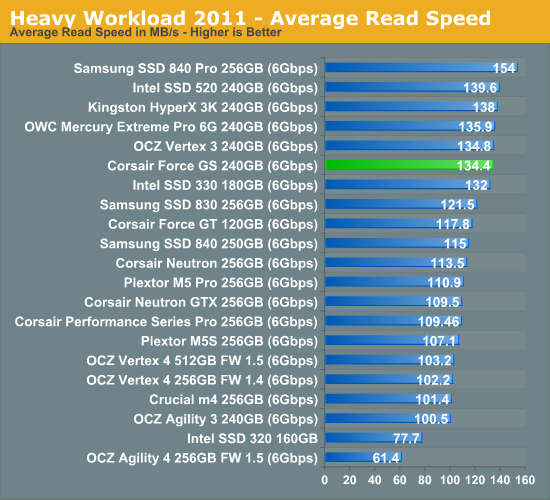
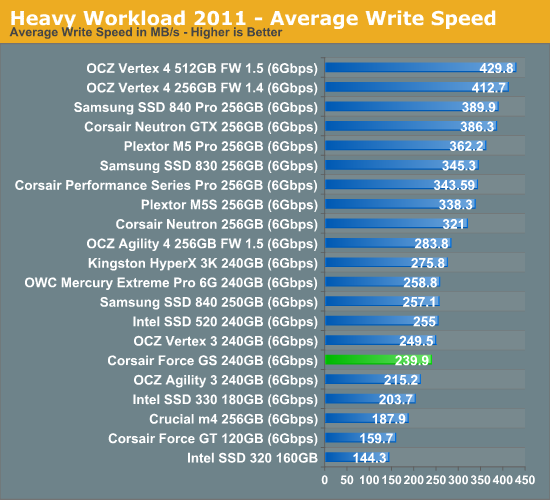
The next three charts just represent the same data, but in a different manner. Instead of looking at average data rate, we're looking at how long the disk was busy for during this entire test. Note that disk busy time excludes any and all idles; this is just how long the SSD was busy doing something:
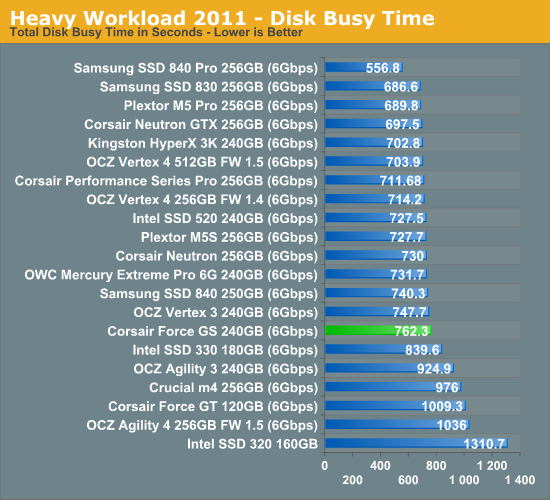
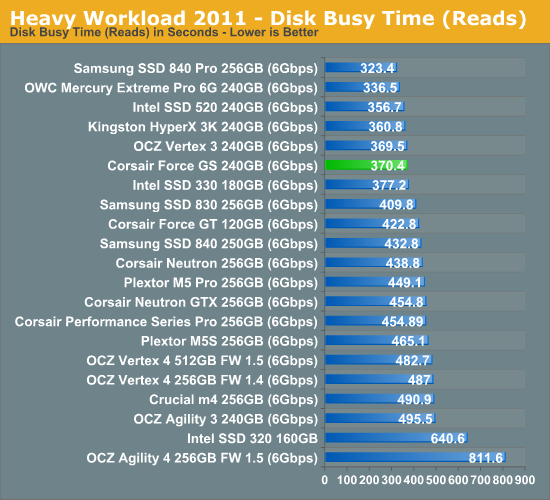
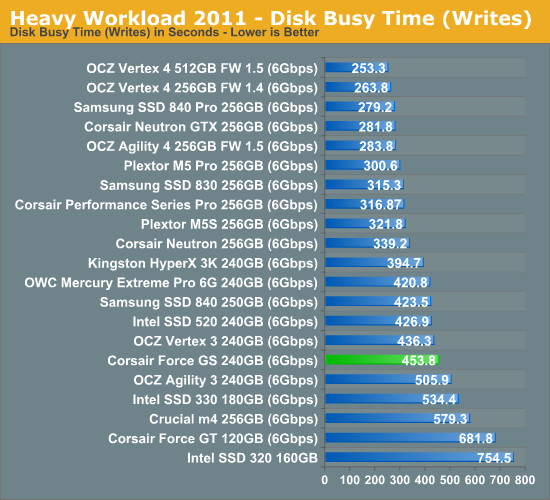










56 Comments
View All Comments
JellyRoll - Saturday, November 24, 2012 - link
Entertaining that you would link to thessdreview, which is pretty much unanimously known as the home of misinformation. Here is a link to the actual slide deck from that presentation, which does not ever mention deduplication.http://www.flashmemorysummit.com/English/Collatera...
CeriseCogburn - Saturday, December 29, 2012 - link
LOL - good job, I will continue to read and see if all the "smart" people have finally shut the H up.I was hoping one would come by, apologize, and thank you.
Of course I know better.
*Happy the consensus is NOT the final word.*
dishayu - Friday, November 23, 2012 - link
Get Kristian on to the next episode of the podcast and make him talk!!popej - Friday, November 23, 2012 - link
What exactly does it mean: "I TRIM'ed the drive after our 20 minute torture"?Shouldn't TRIM function be executed by OS all the time during torture test?
Kristian Vättö - Friday, November 23, 2012 - link
Most of our tests are run without a partition, meaning that the OS has no access to the drive. After the torture, I created a partition which formats the drive and then deleted it. Formatting the drive is the same as TRIMing all user-accessible LBAs since it basically tells the controller to get rid of all data in the drive.popej - Friday, November 23, 2012 - link
Does it mean, that there was no TRIM command executed at all?Not when torturing drive, because it wasn't TRIM supported partition. Not when you "TRIM'ed" drive, because it was a format.
While I agree that you can notice some weird effects, why do you describe them as TRIM problems? Sorry, but I don't know how your test could be relevant to standard use of SDD, when TRIM is active all the time.
Kristian Vättö - Friday, November 23, 2012 - link
Formatting is the same as issuing a TRIM command to the whole drive. If I disable TRIM and format the drive, its performance won't restore since the drive still thinks the data is in use and hence you'll have to do read-modify-write when writing to the drive.They are problems in the sense that the performance should fully restore after formatting. If it doesn't, then TRIM does not function properly. Using an extreme scenario like we do it the best for checking if there is a problem; how that affects real world usage is another question. With light usage there shouldn't be a problem but you may notice the degradation in performance if your usage is write intensive.
popej - Friday, November 23, 2012 - link
Basing on you test I would say, that format is not enough to restore drive performance after using it without TRIM. Quite possible that the state of the drive after torture without TRIM is very different to anything you can get when TRIM is active.It would be interesting to compare your test to real life scenario, with NTFS partition and working TRIM.
Kristian Vättö - Friday, November 23, 2012 - link
With most SSDs, formatting the drive will fully restore it's performance, so the behavior we're seeing here is not completely normal.Remember that even if TRIM is active at all times, sending a TRIM command to the controller does not mean the data will be erased immediately. If you're constantly writing to the SSD, the controller may not have time to do garbage collection in real time and hence the SSD may be pushed to a very fragmented state as in our test where, as we can see, TRIM doesn't work perfectly.
I know that our test may not translate to real world in most cases, but it's still a possible scenario if the drive is hammered enough.
JellyRoll - Friday, November 23, 2012 - link
If the majority of your tests are conducted without a partition that means none of the storage bench results are with TRIM?